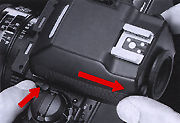An eyepiece shutter is incorporated on both DE-2 and DE-3 finders to prevent stray light entering from behind, which might affect the camera's metering. Note: it was a feature first used on the multimode Minolta XD-7(11) in 1976.
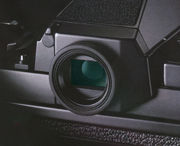 |
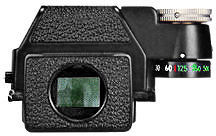 |
|
But Nikon can still
safely claim that no other 35mm SLRs matches the virtual 100% viewfinder coverage
and centring accuracy of the professional class F-series models, a tradition the
F3 shares with its famous predecessors and the current flagship model Nikon F5
and earlier Nikon F4. Over the years, despite the great rivalry between Canon
and Nikon, this is one area that Nikon has always excelled. The Canon New F-1, despite having the advantage
of delaying its launch a year later than the Nikon F3, can only achieved 97% finder
view of the actual picture coverage (similar class bodies like the Contax RTS II and the Pentax LX also boosted similar
result of 97% as the Canon New F-1). However, the Canon EOS-1 introduced in 1989 was the
first Canon body to achieve the 100% finder field view standard. But at the
expense of interchangeable finder feature (May be commercially Canon thought the
feature not viable - that make Nikon the sole remaining camera manufacturer that
still offer this unique feature). The problem, perhaps lays at the great precision
standard required during manufacturing and thus enabled assembling of individual
parts into complete units. Tolerance in manufacturing has to be extremely precise
to enable such high standard of fabrication to be done.
The Nikon F & F2 have similar 100% coverage of the picture field, both
are mechanical cameras while the F3 (And the later LE models), obviously with lesser
mechanical components are still offering this precise and sometimes very useful specification.
A professional camera such as the Nikon F2 body consists of the die cast aluminium
alloy shell, base plate, mirror box, front cover, top plate, bottom cover and camera
back. With each of the total 1,506
component parts,
designed, processed, finished and assembled into a camera.
 |
|
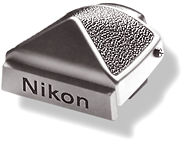 |
|
The F2's interchangeable finder system varies in performance based on the metered prism used. The F3 system is more simplified and straight forward, it is easy to remove and replace the finder assembly. Metering is more precise as the SPD cell is so close to the film plane and reads ambient and as well as TTL flash exposure.
Some of the finders between the Nikon F and F2 may be possible to interchange with one another. Not the case with the F3 - they are not compatible with the earlier F2 nor with the Nikon F4. But the Nikon F3 interchangeable finder system is designed differently from the previous F & F2 models, in favour of a simpler, quicker, secure interchange with one hand operation, even if you are wearing gloves. They are designed as easy to change as the focusing screen. By just pulling back both release levers, you can lift the viewfinder out in an upward direction. To mount, just snap it downward and it will lock in place by the the two hooks on each side. Each finder has its own design for optimum protection against dust and moisture (Generally, users used to regard the Nikon F3-P (Press) which came with a newer DE-4 finder has the best seal against dust and moisture, but I think it all started with the F3 Titan (Champaign finish) that was introduced in back 1983, the DE-3 has a higher rubber seal than the earlier DE-2, that was the only improvement visually I can detect).
 |
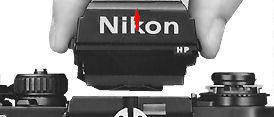 |
|
Although during initial stage I was a little sceptical about how secure the F3's viewfinder locking system worked, it feels a little 'fragile' as compared with the New F-1 or the LX's way of double rails locking system. But time has proved F3's design is as reliable and secure as its rugged body. However, starting from Nikon F4 (and the current F5 as well), Nikon has adopted the double railing lock system used in the New F-1 and LX to change its finder. Right
Pix: Nikon F4 and F5 has a different
way of
releasing the finder.
---------->
|
|
|
| | | Back to Index of Nikon F3 Models Back to Pictorial History of Nikon SLRs |
|
|||||
|
|||||||
| Back |
Index Page of F3 Prisms
| Back |
Main Index Page of Nikon F3 models
| About this photographic site | Contributions and Credits |
 |
Home - Photography in Malaysia |
